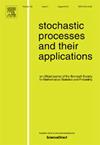Strang splitting for parametric inference in second-order stochastic differential equations
IF 1.2
2区 数学
Q3 STATISTICS & PROBABILITY
引用次数: 0
Abstract
We address parameter estimation in second-order stochastic differential equations (SDEs), which are prevalent in physics, biology, and ecology. The second-order SDE is converted to a first-order system by introducing an auxiliary velocity variable, which raises two main challenges. First, the system is hypoelliptic since the noise affects only the velocity, making the Euler–Maruyama estimator ill-conditioned. We propose an estimator based on the Strang splitting scheme to overcome this. Second, since the velocity is rarely observed, we adapt the estimator to partial observations. We present four estimators for complete and partial observations, using the full pseudo-likelihood or only the velocity-based partial pseudo-likelihood. These estimators are intuitive, easy to implement, and computationally fast, and we prove their consistency and asymptotic normality. Our analysis demonstrates that using the full pseudo-likelihood with complete observations reduces the asymptotic variance of the diffusion estimator. With partial observations, the asymptotic variance increases as a result of information loss but remains unaffected by the likelihood choice. However, a numerical study on the Kramers oscillator reveals that using the partial pseudo-likelihood for partial observations yields less biased estimators. We apply our approach to paleoclimate data from the Greenland ice core by fitting the Kramers oscillator model, capturing transitions between metastable states reflecting observed climatic conditions during glacial eras.
二阶随机微分方程参数推理的奇异分裂
我们讨论了二阶随机微分方程(SDEs)的参数估计,这在物理学、生物学和生态学中很普遍。通过引入辅助速度变量将二阶SDE转换为一阶系统,这提出了两个主要挑战。首先,系统是半椭圆的,因为噪声只影响速度,使得Euler-Maruyama估计是病态的。为了克服这个问题,我们提出了一种基于斯特朗分裂方案的估计器。其次,由于速度很少被观测到,我们使估计器适应部分观测。我们提出了四种完全和部分观测的估计,使用完全伪似然或仅基于速度的部分伪似然。这些估计具有直观、易于实现、计算速度快等特点,并证明了它们的一致性和渐近正态性。我们的分析表明,使用具有完全观测值的完全伪似然减少了扩散估计量的渐近方差。对于部分观测,渐近方差由于信息损失而增加,但不受似然选择的影响。然而,对Kramers振荡器的数值研究表明,对部分观测使用部分伪似然可以得到较小的偏估计。我们通过拟合克莱默斯振荡器模型,将我们的方法应用于格陵兰冰芯的古气候数据,捕捉反映冰川时期观测到的气候条件的亚稳态之间的转变。
本文章由计算机程序翻译,如有差异,请以英文原文为准。
求助全文
约1分钟内获得全文
求助全文
来源期刊

Stochastic Processes and their Applications
数学-统计学与概率论
CiteScore
2.90
自引率
7.10%
发文量
180
审稿时长
23.6 weeks
期刊介绍:
Stochastic Processes and their Applications publishes papers on the theory and applications of stochastic processes. It is concerned with concepts and techniques, and is oriented towards a broad spectrum of mathematical, scientific and engineering interests.
Characterization, structural properties, inference and control of stochastic processes are covered. The journal is exacting and scholarly in its standards. Every effort is made to promote innovation, vitality, and communication between disciplines. All papers are refereed.
 求助内容:
求助内容: 应助结果提醒方式:
应助结果提醒方式:


